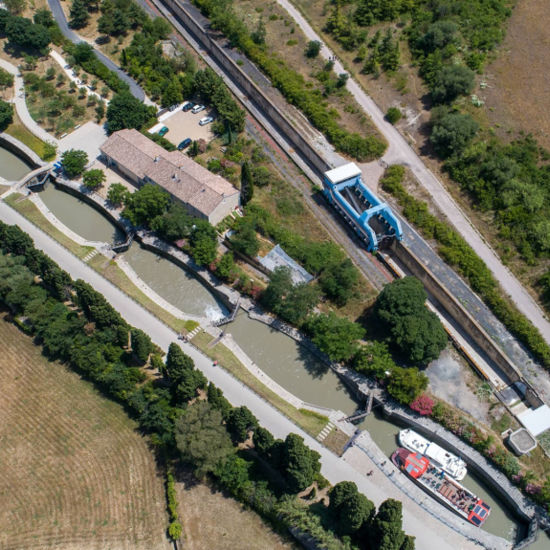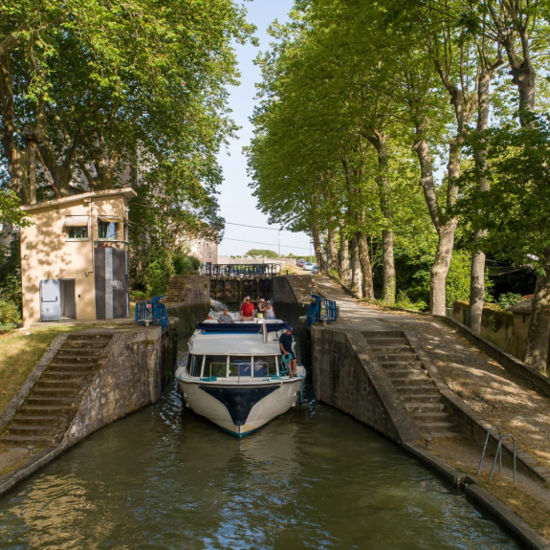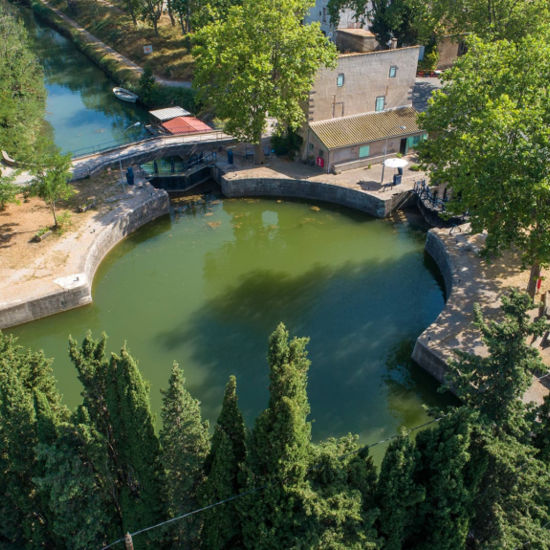
The Canal du Midi locks:
engineering structures
that are key to navigation
There are so many locks along the Canal du Midi, and they can be recognised by their distinctive oval shape. These engineering structures are absolutely essential to navigation and some of them are particularly ingenious.
Number of locks on the Canal du Midi
There would be no canal without the locks. There are 77 of them in total along the Canal du Midi and its branches.
All boats are obliged to pass through them, they are essential to navigation.
-
63 locks
on the Canal du Midi -
13 locks
on the Canal de Jonction
and Canal de la Robine in Narbonne -
1 lock
on the Canal de Brienne
in Toulouse
The lock is a staircase for boats
The locks help to overcome the 189 metres difference in altitude along the Canal du Midi, in successive sections, between the Seuil de Naurouze, the highest point of the canal, and the sea level.
They are used both to raise and lower boats! That's why the locks are like staircases for boats.
How does a lock work?
A lock is a simple yet ingenious structure.
A lock consists of a chamber (basin), enclosed at either end by mitre gates with two leaves.
Boats pass through these locks in 3 stages, according to the principle of communicating vessels:
1. When a boat travelling upstream approaches, the downstream (bottom) gate opens and the boat enters the lock chamber.
2. The downstream gate closes behind the boat. The sluices (valves) on the upstream gate are then opened. Under the effect of pressure, the water from the upper canal pound flows into the chamber and raises the boat until the chamber and the pound are at the same level.
3. When the chamber and canal pound are at the same level, the gate opens and the boat can continue.

The locks with multiple chambers
designed by Riquet
Back then, to make the manoeuvres easier, Riquet decided to limit the maximum height of the lock chambers to 2.9 metres. But this decision meant that it was necessary to create a series of chambers.
Why did Riquet limit the depth of the locks? The first locks he designed only had one chamber. Very quickly he realised that the significant depth of the chambers was damaging the structural work and the gates were not easy to manoeuvre.
Therefore, to allow boats to overcome significant differences in altitude without having to build deep locks, Riquet built locks with multiple chambers: double, triple or even quadruple locks such as Saint-Roch lock in Castelnaudary with a total elevation of 9.42 m.
The most impressive lock in France is Fonseranes lock in Béziers. This lock is in fact a series of 8 chambers and 9 lock gates! It is an exceptional engineering structure that allows boats to be raised or lowered 21.5 metres!!
Did you know?
To reach Thau lagoon from Toulouse today, boats need to pass through 45 single locks, 12 double locks, 4 triple locks, 1 quadruple lock and even 1 lock with eight chambers! This is why we often speak of flights of locks.
The remarkable locks on the Canal du Midi
Some of the locks on the Canal du Midi are really extraordinary. Come and see them, they are worth the detour, either by car, on foot or by bike!
The characteristic shape of the Canal du Midi locks
You may have noticed that one of the original characteristics of the Canal du Midi locks is that the chambers are oval shaped.
Locks that were rectangular at first
The first locks to be built on the Canal du Midi were in Toulouse. Some examples are the Embouchure, Béarnais, Minimes, Matabiau and Bayard locks.
For these first engineering structures, Riquet produced identical copies of the locks on the Canal de Briare, which opened for navigation in 1648. They are rectangular shaped with straight walls.
But in May 1669, an inspection of the construction work reported damage to one of the walls in the Minimes lock. Colbert was under the impression that these structures would last a lifetime and so was surprised. He requested that measures be taken to put an end to this problem.
Then oval-shaped
This damage was due to the extreme pressure the earth was exerting on the lock walls. Riquet studied the issue more closely and opted for locks with walls that were built in a semi-circular shape.
He put this idea to the test at Castanet lock and then applied it to all the other locks on the Canal du Midi. The unique oval shape of the Canal du Midi locks would become a symbol of the canal... as well as making them much more attractive structures!
This technique was also used for the locks built in the 18th century, such as Saint-Pierre lock at the far end of the Canal de Brienne in Toulouse and the locks along the Canal de Jonction and Canal de la Robine in Narbonne were also built according to the same principle.
And then rectangular again!
However, the locks built in the 19th century (Ponts-Jumeaux in Toulouse, Orb in Béziers, Prade in Agde and Sainte-Lucie near Port-La-Nouvelle) were built in the rectangular shape that can be seen on every other canal in France.
Why the change? As you can imagine, over time the resistance calculations became more accurate, construction techniques evolved, as did the quality of construction materials used, and so the structural engineers were able to design straight locks for the Canal de Garonne, built between 1838 and 1856. Keep in mind that rectangular locks were also less costly to build!
Did you know?
The locks through Toulouse were never modified from the early rectangular shape.
The evolution of Canal du Midi locks over time
Compliance with the Freycinet gauge to revive inland waterway traffic
The initial dimensions for the locks on the Canal du Midi were 11 m in width at the centre, 6 m at the gates, and a total length of 30.5 m.
On 5 August 1879, a law was introduced governing the dimensions of the locks in certain canals, known as the Freycinet gauge. To give inland waterway transport a boost and integrate the inland waterways of south-west France into the national and European networks, it was necessary to do some work on the Canal du Midi! This work involved extending the locks by 10 m, so that freight barges (péniches) measuring 38.50 m and weighing 250 tonnes could navigate here.
This was studied in 1903, but the modernisation work on the Canal du Midi was only actually carried out from 1970, and the first task was to bring the Canal de Garonne up to standard. In 1977, the east part of the Canal du Midi and the section around Toulouse was aligned with the Freycinet gauge.
In view of disappointing reaction to this work and in light of budget restrictions in France in the 1980s, the project was abandoned in 1984 by the Ministry of Equipment. Only a handful of locks at each end of the canal were aligned with the standard, and the locks in the central section of the Canal du Midi (140 km) kept the original 17th century dimensions.

Did you know?
They were originally made from wood, but since the 20th century, the various sections of the lock (gates, sluices, etc.) have been metal. The opening mechanisms for the gates and sluices have also evolved since the 17th century, and booms and screws were replaced with rack and pinions and jacks in the mid-19th century.

Détail de porte d'écluse en bois, Lalande, 1778 © VNF, archives canal du Midi
Time to modernise the Canal du Midi locks
In the 1990s, Voies Navigables de France (VNF), in charge of the Canal du Midi management, decided to modify the locks so they could be operated mechanically, and therefore make them easier to use. Manual jacks were replaced with electric motors and the lock keepers would be able to control manoeuvres from a portable console or control stations in a designated location.
A part of the Canal du Midi was even made automatic! This meant that skippers could pass through locks themselves using the automatic terminals. VNF staff would still be on-hand to supervise manoeuvres and carry out any repair or maintenance work.





